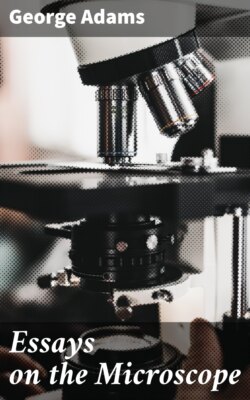Читать книгу Essays on the Microscope - George Comp Adams - Страница 14
На сайте Литреса книга снята с продажи.
OF THE SOLAR MICROSCOPE.
ОглавлениеTable of Contents
In this instrument, the image of the object is refracted upon a screen in a darkened room. It may be considered under two distinct heads: 1st, the mirror and lens, which are intended to reflect and transmit the light of the sun upon the object; and 2dly, that part which constitutes the microscope, or which produces the magnified image of the object, Fig. 10. Plate I. Let N O represent the side of a darkened chamber, G H a small convex lens, fixed opposite to a perforation in the side N O, A B a plane mirror or looking glass, placed without the room to reflect the solar rays on the lens C D, by which they are converged and concentrated on the object fixed at E F.
2. The object being thus illuminated, the ray which proceeds from E will be converged by the lens G H to a focus K, on the screen L M; and the ray which comes from F will be converged to I, and the intermediate points will be delineated between I and K; thus forming a picture, which will be as much larger than the object, in proportion as the distance of the screen exceeds that of the image from the object; a small object, such as a mite, &c. may be thus magnified to eight or ten feet in diameter.
From what has been said, it appears plainly, the advantages we gain by microscopes are derived, first, from their magnifying power, by which the eye is enabled to view more distinctly the parts of minute objects: secondly, that by their assistance, more light is thrown into the pupil of the eye, than is done without them. The advantages procured by the magnifying power, would be exceedingly circumscribed, if they were not accompanied by the latter: for if the same quantity of light be diffused over a much larger surface, its force is proportionably diminished; and therefore the object, though magnified, will be dark and obscure. Thus, suppose the diameter of the object to be enlarged ten times, and consequently the surface one-hundred times, yet, if the focal distance of the glass were eight inches, provided this were possible, and its diameter only about the size of the pupil of the eye, the object would appear one-hundred times more obscure when viewed through the glass, than when it was seen by the naked eye; and this even on the supposition that the glass transmitted all the light which fell upon it, which no glass can do. But if the glass were only four inches focal distance, and its diameter remained as before, the inconvenience would be vastly diminished, because the glass could be placed twice as near the object as before, and would consequently receive four times as many rays as in the former case, and we should, therefore, see it much brighter than before. By going on thus, diminishing the focal distance of the glass, and keeping its diameter as large as possible, we shall perceive the object proportionably magnified, and yet remain bright and distinct. Though this is the case in theory, yet there is a limit in optical instruments, which is soon arrived at, but which cannot be passed. This arises from the following circumstances.[27]
